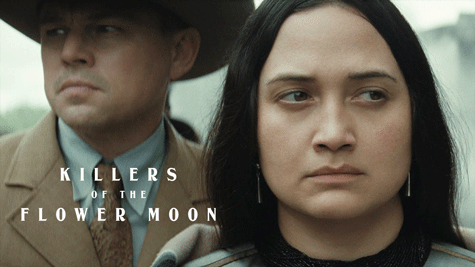This year’s movies are longer than ever
Christopher Nolan’s Oppenheimer is three hours long. So is Martin Scorsese’s Killers of the Flower Moon. Those are among the longest. What’s going on? Center director Jeffrey Cole digs in.
By Jeffrey Cole
(Note: You don’t have to read my last column about movie length to understand this one; but click here if you’d like to check it out.)
Let’s start with Martin Scorsese.
There isn’t a more talented or respected film maker. He started directing films in the late 1960s. At 80, he is as productive as ever.
As Scorsese built his reputation, his films got longer. His first film, Who’s That Knocking at My Door (1967) was 90 minutes. His second, Boxcar Bertha (1972) was shorter at 87 minutes.
 Those lengths seem tiny compared to his last four films. The Wolf of Wall Street (2013) was 180 minutes. Silence (2016) came in at a relatively short 161 minutes. The Irishman (2019) is his longest film at 209 minutes. This year’s Killers of the Flower Moon is almost as long at 206 minutes.
Those lengths seem tiny compared to his last four films. The Wolf of Wall Street (2013) was 180 minutes. Silence (2016) came in at a relatively short 161 minutes. The Irishman (2019) is his longest film at 209 minutes. This year’s Killers of the Flower Moon is almost as long at 206 minutes.
Scorsese finished The Irishman before the COVID pandemic; it was intended for movie theaters. When all theaters closed, it was sold to Netflix, where it became a major prestige film. The web was full of guides sharing—depending on whether you wanted to watch it in one or more parts—the best points to break for the bathroom or until the next day. During COVID, we didn’t care if The Irishman was four and a half hours! With a pause button and the ability come back whenever you want, there are different rules for length in streaming.
As Scorsese became a legendary director, he was not only able to take as long as he wanted, he also chose material suited for long story telling, unlike his first films. Looking at the quality of his recent work, it is hard to dispute that he earned the right to go long. Still, modest cuts might not have hurt.
James Cameron’s career has followed the arc of Scorsese’s—with later films much longer than earlier ones. Cameron is the most commercially successful director of all time, with three of the top five grossing films. His first film Piranha II: The Spawning (1982) was a brisk 90 minutes. The first Terminator (1984) was 107 minutes. That success opened the floodgates to much longer movies. Titanic in 1997 won Best Picture at 195 minutes. The two Avatar films are 162 minutes and 192 minutes, respectively.
The story is the same with Peter Jackson. His first movie, Bad Taste (1987), was an efficient 92 minutes. Success and experience also let Jackson go long—very long! The Lord of the Rings films were immensely long at 178, 179, and 201 minutes for a three-film total of 9.3 hours. That was before the extended director’s cuts!
It’s not just veteran directors who catch this disease. A younger example is Damien Chazelle. His first breakout hit was Whiplash (2014) at 106 minutes. He followed that with La La Land (2016) at 128 minutes. La La Land was a massive commercial success. It won Chazelle, then 31, the Oscar for Best Director (and for a moment, Best Picture).
La La Land let Chazelle join the “go long” club.
His next movie, First Man (2018) was 141 minutes long. But it was Babylon in 2022 where he really exercised his power by making a film at 189 minutes.
Babylon had many moments of brilliance, but it was obvious to any viewer that entire scenes could have been cut to make it better. Whether it was hubris, a feeling of invulnerability, or the lack of a good editor, the film was too long.
Chazelle is a brilliant director who now has something to prove. Look for his next film to be considerably shorter and more like Whiplash. He has a great career ahead of him and may look back pleased that he learned the lessons of Babylon early.
Scorsese, Cameron, Jackson, and Chazelle led a trend. The top 10 grossing movies of the year in 1981 averaged 110 minutes. By 2001, the average was 126 minutes. In 2021, it was 131 minutes.
Length used to be a sign of the quality of the story, the great narrative that needed to be covered, and a director (or, in the case of streaming, a writer/producer), with a great reputation for combining quality with success. That is sometimes still true. However, excessive length has also become a perk to hand out to modestly successful directors for stories that do not necessarily merit it.
What changed was who could make a long film. Until 2000, it was revered directors known for combining quality with success. Now, almost any director with a modest hit wants their next film to go long and go Scorsese.
Of the 10 longest Hollywood films of 2022, only Cameron’s Avatar: The Way of Water was a blockbuster.
In 2023, in addition to Scorsese’s Killers of the Flower Moon, Christopher Nolan’s Oppenheimer will clock in at 180 minutes. It is his longest film ever, although several others have come close.
Long films aren’t just for famous directors anymore
2023 is full of long films by relatively unknown directors. This is a new phenomenon.
Action films, which used to average about 100 minutes, are longer this year. John Wick 4 breaks new ground for action movie length at 159 minutes. Indiana Jones and the Dial of Destiny is close at 154 minutes. Guardians of the Galaxy: Vol. 3 runs 150 minutes (Vol. 1 ran 121 minutes). The Flash is 144 minutes. Fast X is 141 minutes. Leading the pack, we find Beau is Afraid, a drama (directed by Ari Aster and starring Joaquin Phoenix) at a colossal 179 minutes.
It’s time to bring back editors.
Movie Mitosis: how many parts can one action movie have?
Another trend concerns stories that cannot be told in one film, no matter how long it may be.
Here, I’m not talking about sequels but the continuation of a single story. Even though The Fast and the Furious car-chase franchise has had ten separate films to tell its story, for the tenth installment, Fast X, the director felt there was so much more to say that the studio broke it into Part I this year (141 minutes) and Fast X: Part II, presumably next year, at a yet-to-be-disclosed length.
The same is true of Mission Impossible: Dead Reckoning. Part One which opened at 156 minutes. Part II (length currently unknown) opens next summer. In fairness to Mission Impossible, if any creative force has earned the right to do whatever he wants, it is Tom Cruise, especially after Top Gun: Maverick.
Movie mitosis, the division into parts, has been around for a while, but not for films like The Fast and the Furious.
Following up on the mega success of The Lord of the Rings trilogy, Peter Jackson took a story barely longer than a post-it note (a very short book) and turned The Hobbit into three full-length movies totaling 474 minutes. Audiences could tell it was bloated and not based much on Tolkien’s stories. It underperformed.
The last film in a series frequently breaks in two. We saw this with The Hunger Games, Twilight, Dune, and Harry Potter. It is a way to make the movie magic (not to mention the money) last a little longer, although usually it dilutes the magic.
As streaming came along, it offered new creative opportunities. A television series no longer had to fit into a cookie cutter mold of 22 episodes. It could be as long as it needed to be. If fewer episodes were made, they could be a higher, more consistent quality.
At least that was the plan.
Streaming series are usually 10 episodes, whether they warrant that number or not. (Once again, this is a way to amortize costs.) Queen Charlotte: A Bridgerton Story ran six episodes, but one episode was a series recap in the middle: there was no need for six.
Ironically, two of the best streaming series made too few episodes. The third season of Succession made only nine episodes instead of the ten from the previous two seasons. It went back to ten (with extra-long episodes) for the final season. The White Lotus avoided bloat by making six episodes in its first season and seven in the second. Both examples may have more to do with Warner Discovery keeping costs down.
Length used to be a sign of the quality of the story, the great narrative that needed to be covered, and a director (or, in the case of streaming, a writer/producer), with a great reputation for combining quality with success.
That is sometimes still true. However, excessive length has also become a perk to hand out to modestly successful directors for stories that do not necessarily merit it.
Many movie theaters have installed recliners. Many homes have big screens we watch from cushy sofas. These things make a lengthy viewing experience more comfortable.
But the movies and shows we watch still have to earn our attention.
____________

Jeffrey Cole is the founder and director of The Center for the Digital Future at USC Annenberg.
See all columns from the center.
July 19, 2023

